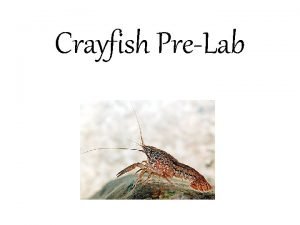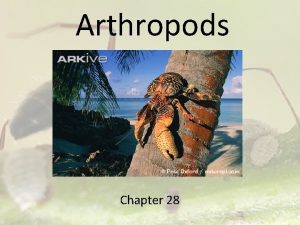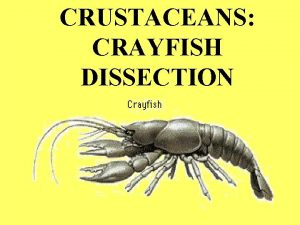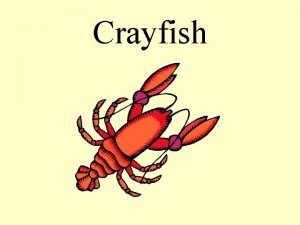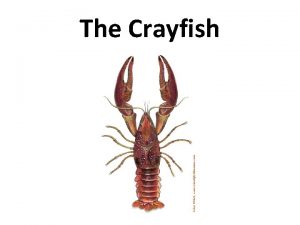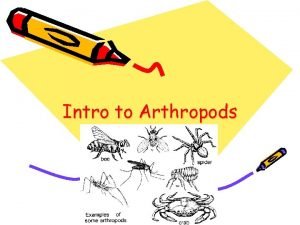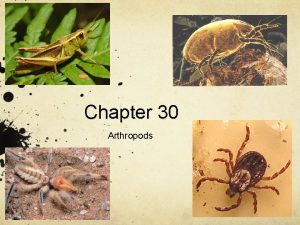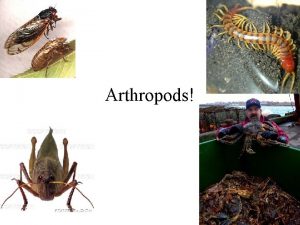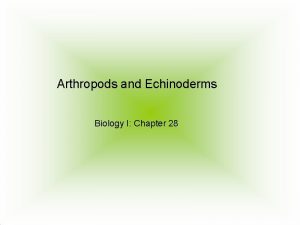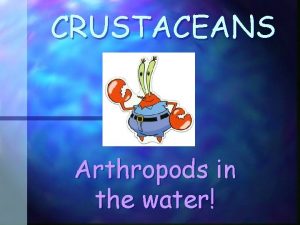Crayfish F Crayfish are small freshwater arthropods that











- Slides: 11


Crayfish F Crayfish are small, freshwater arthropods that resemble lobsters. They are usually brownish-green in color, but some species may be white, pink, or even blue. Freshwater crayfish are divided into two family groups. Parastacidae in the southern hemisphere and astacidae in the northern.

Crayfish F Crayfish can be found in a variety of freshwater environments throughout the world. Found in temperate waters such as ponds and streams, they spend the day hiding under rocks and other objects for protection. F They are scavengers, and so at night they come out to feed on decaying plant matter, insect larvae, small fish, and worms.

Crayfish F Freshwater crayfish vary in size, depending upon the species. Under good conditions commercial crayfish will grow about 100 grams per year before they are shipped out. One species of Australian crayfish, however, can reach 200 kilograms.

Growth F Crayfish, due to the molting process, grow at a stepped exponential rate. After each molt the crayfish grows rapidly in size until the shell hardens. The crayfish then pumps the body cavity full of water to enlarge the shell. This happens after molting, but while the new shell is still soft. Normally the shell hardens within 2 days after molting. During the molting process, the redclaw stores calcium taken from the old shell in 2 gastroliths, or calcium buds, within the stomach.

Breeding F Most species breed only once or twice per year. The eggs are laid and fertilized within the curled tail of the female crayfish. The eggs are attached to the pleopods by specialized cement glands located on the tail of the female crayfish. While most species breed only once or twice a year, female redclaw are capable of spawning up to 6 times per year.

Crayfish Aquaculture F Crayfish aquaculture, the raising of crayfish for food and commercial purposes, has focused mainly on the redclaw species of crayfish.

Crayfish Aquaculture F Cherax quadricarinatus, which is native to the southern hemisphere, is healthier to eat than most traditional seafood. Redclaw meat is low in fat, cholesterol, and salt. Their ability to reach 500 grams, go long periods of time without water, and go without oxygen for up to six hours, make them very profitable to raise and easy to transport.

Crayfish Aquaculture F The redclaw get their name from the red patches on the claws of the males, females however, have lighter, blue-colored claws

Bibliography F Academic American Encyclopedia vol. 5 Pg. 363, copyrighted 1997. F www. powerup. com. au/~jtysoe/crayfish/biol. html

 Antigentest åre
Antigentest åre Tìm vết của mặt phẳng
Tìm vết của mặt phẳng Sau thất bại ở hồ điển triệt
Sau thất bại ở hồ điển triệt Thể thơ truyền thống
Thể thơ truyền thống Con hãy đưa tay khi thấy người vấp ngã
Con hãy đưa tay khi thấy người vấp ngã Thơ thất ngôn tứ tuyệt đường luật
Thơ thất ngôn tứ tuyệt đường luật Tôn thất thuyết là ai
Tôn thất thuyết là ai Phân độ lown
Phân độ lown Chiến lược kinh doanh quốc tế của walmart
Chiến lược kinh doanh quốc tế của walmart Gây tê cơ vuông thắt lưng
Gây tê cơ vuông thắt lưng Premature atrial contraction
Premature atrial contraction Crayfish virtual dissection
Crayfish virtual dissection











